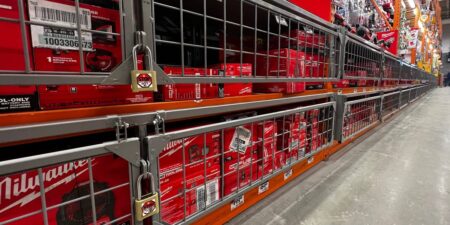CarMax, Inc. (NYSE: KMX), the nation’s largest retailer of used cars, reported a slight decrease in total sales to $7 billion in the fiscal second quarter of 2025, a 1% drop year-over-year. However, the company saw a 5.1% increase in retail unit sales.
The average selling price for used vehicles fell by 5%, while the retail gross profit per used unit remained stable at $2,269. CarMax Auto Finance (CAF) experienced a 14% decline in income, primarily due to increased loan loss provisions. Despite the challenging market, CarMax remains optimistic about its growth prospects and continues to innovate with digital tools and enhanced customer experience initiatives.
Key Takeaways
- CarMax’s total sales were down 1% year-over-year, with retail unit sales up 5.1%.
- The average selling price for used vehicles declined by 5%.
- Retail gross profit per used unit remained steady at $2,269.
- CAF income decreased by 14% due to higher loan loss provisions.
- Digital and omni-channel sales now represent 57% of retail unit sales.
- Net earnings per diluted share increased by 13% to $0.85.
- The company conducted its first non-prime asset-backed securities transaction and is testing new credit scoring models.
- CarMax is optimistic about continued growth in the second half of the year.
Company Outlook
- CarMax plans to centralize logistics operations to improve efficiency.
- The company is testing a generative AI knowledge management system for associates.
- An EV Hub has been launched on the CarMax website to support electric vehicle education.
- Management expects positive sales trends to continue and growth in the second half of the year.
Bearish Highlights
- CAF’s income was impacted negatively by increased loan loss provisions amid industry-wide challenges.
- The reserve for potential losses was $52 million, considered an outlier compared to previous quarters.
- A significant adjustment of $30 million is expected in the provision for loan losses.
Bullish Highlights
- CarMax completed a nationwide rollout of a new order processing system.
- The company remains confident in its credit platform and lender relationships.
- Other gross margins increased by 33% year-over-year, driven by service and Extended Protection Plans improvements.
Misses
- Total sales slightly decreased by 1% compared to the previous year.
- There was a notable decline in the average selling price for used vehicles.
Q&A Highlights
- Executives noted that used car unit comps were improving due to internal efficiencies and macroeconomic factors.
- Advertising spending variations are typical, and overall expenditures align with first-half expectations.
- Tier 3 credit penetration decreased to 7%, attributed to consumer affordability issues.
- The profile of consumers in the financing channel is typically higher-end buyers.
CarMax’s earnings call underscored the company’s resilience and adaptability in a challenging market. While total sales saw a marginal decrease, the increase in retail unit sales and the stability of retail gross profit per unit indicate strong operational performance. The decline in CAF income due to higher loan loss provisions reflects the broader industry trend of tightening credit conditions, which CarMax is addressing with strategic initiatives such as new credit scoring models and asset-backed securities transactions.
The company’s focus on digital innovation and customer experience, as evidenced by the rollout of new transaction tools and the testing of AI systems, positions CarMax well for future growth. The optimism of CarMax’s management, coupled with the reported increase in net earnings per diluted share, suggests confidence in the company’s direction and its ability to navigate the current market landscape.
CarMax’s commitment to enhancing its service offerings and expanding its credit reach, while managing risks and maintaining profitability, reflects a balanced approach to growth. With a positive outlook for the second half of the year and ongoing strategic improvements, CarMax appears poised to continue its trajectory in the used car retail market.
InvestingPro Insights
CarMax, Inc. (NYSE: KMX) has been navigating a complex automotive market landscape, as reflected in their recent sales report. To provide a deeper financial context, InvestingPro data and tips offer additional insights into the company’s performance and valuation.
InvestingPro Data highlights CarMax’s market capitalization at $12.27 billion, with a Price-to-Earnings (P/E) ratio of 31.11, which is higher than the adjusted P/E for the last twelve months as of Q1 2023, standing at 27.3. This elevated P/E ratio suggests that the market has high expectations for the company’s future earnings growth. Despite a decrease in revenue by 6.31% over the last twelve months, CarMax maintains a Gross Profit Margin of 11.79%, indicating its ability to control cost of sales relative to revenue.
InvestingPro Tips reveal that CarMax is trading at a high earnings multiple, which may be a point of caution for value-focused investors. Additionally, analysts anticipate a sales decline in the current year, which aligns with the reported 1% drop in total sales in the fiscal second quarter of 2025. On the positive side, CarMax is recognized as a prominent player in the Specialty Retail industry, and its stock price movements are quite volatile, which could present opportunities for traders looking for short-term gains. Moreover, the company’s liquid assets exceed short-term obligations, providing financial flexibility.
For readers interested in a comprehensive analysis, InvestingPro offers additional tips on CarMax’s financial health and future prospects. There are 11 more InvestingPro Tips available, which can be accessed for a deeper dive into the company’s performance metrics and industry standing. These insights may prove invaluable for investors looking to make informed decisions about their investments in CarMax.
Full transcript – CarMax Inc (NYSE:) Q2 2025:
David Lowenstein: Thank you, Todd. Good morning, everyone. Thank you for joining our fiscal 2025 second quarter earnings conference call. I’m here today with Bill Nash, our President and CEO; Enrique Mayor-Mora, our Executive Vice President and CFO; and Jon Daniels, our Senior Vice President, CarMax Auto Finance operations. Let me remind you, our statements today that are not statements of historical fact, including statements regarding the company’s future business plans, prospects, and financial performance are forward-looking statements we make pursuant to the Safe Harbor provisions of the Private Securities Litigation Reform Act of 1995. These statements are based on our current knowledge, expectations, and assumptions and are subject to substantial risks and uncertainties that could cause actual results to differ materially from our expectations. In providing projections and other forward-looking statements, we disclaim any intent or obligation to update them. For additional information on important factors and risks that could affect these expectations, please see our Form 8-K filed with the SEC this morning, our Annual Report on Form 10-K for the fiscal year 2024 and our quarterly results on Form 10-Q, previously filed with the SEC. Should you have any follow-up questions after the call, please feel free to contact our Investor Relations Department at 804-747-0422, extension 7865. Lastly, let me thank you in advance for asking only one question and getting back in the queue for more follow-ups. Bill?
Bill Nash: Great. Thank you, David. Good morning, everyone, and thanks for joining us. We’re pleased with our team’s execution in the second quarter, as we achieve positive sales trends, strong margins, cost efficiencies, and EPS growth, while managing through industry-wide auto loan loss pressure. Beyond great execution, our results also reflect the positive impact of delivering associate and customer experience enhancements alongside declining prices and a more stable environment for vehicle valuations. In the second quarter, we grew retail unit volume year-over-year. We delivered strong retail and wholesale GPUs and expanded EPP and service gross profit. We bought more vehicles from dealers, achieving a second quarter record. We maintained stable CAF net interest margin and began to test our new full spectrum underwriting model. We materially levered SG&A as a percent of gross profit and we achieved double-digit EPS growth. For the second quarter of FY ‘25, our diversified business model delivered total sales of $7 billion, down 1% compared to last year, reflecting lower retail and wholesale prices, partially offset by higher retail volume. In our retail business, total unit sales increased 5.1% and used unit comps were up 4.3%. Average selling price declined approximately $1,250 per unit or 5% year-over-year. Second quarter retail gross profit per used unit was $2,269, consistent with last year’s $2,251. Also, unit sales are down 0.3 versus the second quarter last year and improved sequentially from being down 8.3% in the first quarter of this year. Average selling prices declined approximately $1,150 per unit or 13% year-over-year. Second quarter wholesale gross profit per unit was $975 in line with $963 a year ago. We bought approximately 300,000 vehicles during the quarter, up 3% from last year. We purchased approximately 269,000 vehicles from consumers with more than half of those buys coming through our online instant appraisal experience. With the support of our Edmund sales team, we sourced the remaining approximately 31,000 vehicles through dealers up 60% from last year. We continue to see increased adoption of our omni-channel retail experience. For our second quarter online metrics, approximately 15% of retail unit sales were online up from 14% last year. Approximately 57% of retail unit sales were omni-sales this quarter, up from 55% in the prior year. Total revenue from online transactions was approximately 29%, slightly down from last year due to wholesale pricing coming down. All of our second quarter wholesale auctions and sales were virtual and are considered online transactions, which represented 17% of total revenue for the quarter. CarMax Auto Finance or CAF delivered income of $116 million, down 14% from the same period last year. CAF results were pressured by an uptick in losses that are being experienced industry-wide. In a few minutes, Jon will provide more detail on customer financing, the loan loss provision, cap contribution, and our progress on becoming a full credit spectrum lender. But at this point, I’d like to turn the call over to Enrique, who will share more information on our second quarter financial performance. Enrique?
Enrique Mayor-Mora: Thanks, Bill, and good morning, everyone. As Bill noted, we delivered on multiple fronts in the quarter, positive retail unit comps, robust vehicle margins, material growth, and other gross profit per retail unit, maintaining CAFs net interest margin, and strong flow through to the bottom line. Second quarter net earnings per diluted share was $0.85, up 13% versus a year ago. This was despite the increase in our loan loss provision. Total gross profit was $760 million, up 9% from last year’s second quarter. Used retail margin of $479 million increased by 6% with higher volume and relatively flat per unit margins. Wholesale vehicle margin of $138 million grew by 1% with margins offsetting a slight decrease in volume. Other gross profit was $144 million, up 33% from a year ago. This was driven primarily by a combination of EPP and service. EPP increased by $20 million as we continued to benefit from the higher max care margins per contract that we previously ruled out. Service delivered $3 million in margin, up $17 million from last year’s second quarter. This performance reflected the combined impact of successful efficiency and cost coverage measures and positive sales growth. We expect continued year-over-year improvement for the balance of the year, as governed by sales performance given the leverage-deleverage nature of service. On the SG&A front, expenses for the second quarter were $611 million, up 4%, or $25 million from the prior year’s quarter, but leveraged 4 percentage points supported by our continued discipline in spend and investment levels. This SG&A leverage would have been even stronger, if not for two main factors that impacted the second quarter. First, total compensation and benefits increased by $16 million. This was primarily driven by our corporate bonus accrual, which was lowered in last year’s second quarter. Second, occupancy costs rose by $7 million, a higher increase in recent trends driven by the timing of store maintenance related spend. I also want to point out two noteworthy items. First, our omnichannel selling model, which includes commissions plus the cost of operating our CECs, continues to be more efficient as we further strengthen our digital progression tools and the optimal use of CEC labor. This quarter, we were more efficient year-over-year and versus pre-omni in the three key metrics, per retail unit, per total unit, and per gross margin dollar. Second, as Bill will discuss further, we continue to evaluate all aspects of our logistics operations to drive efficiencies. This includes equipment and leasing arrangements. As part of this evaluation, we may incur charges that we estimate will be less than $10 million in the near-term that would likely hit other income expense line. These charges will be more than offset by the efficiencies gained in our logistics operations over time. Regarding capital allocation, during the second quarter we repurchased approximately 1.4 million shares for a total spend of $106 million. As of the end of the quarter, we had approximately $2.15 billion of repurchase authorization remaining. Now I’d like to turn the call over to Jon.
Jon Daniels: Thanks, Enrique, and good morning, everyone. During the second quarter, CarMax Auto Finance originated approximately $2.2 billion, resulting in sales penetration of 42% net of three-day payoffs, as compared to 42.8% during last year’s second quarter. The weighted average contract rate charged to new customers was 11.5% and increased to 40 basis points from a year ago. Third-party Tier 2 penetration in the quarter was 17.7%, down slightly from 18.1% a year ago. And third-party Tier 3 volume accounted for 6.7% of sales, compared to the 6.4% seen in last year’s second quarter. The combined third-party penetration of 24.4% remains in line with Q2 FY ‘24. CAF income for the quarter was $116 million, down $19 million from the same period last year, predominantly impacted by a year-over-year provision increase of $23 million. Net interest margin for the quarter was 6.1% in line with last year. The provision for loan losses for the quarter was $113 million and resulted in a reserve balance of $501 million. This compares to a provision of $90 million in last year’s second quarter. Included in the $113 million provision is a $52 million, roughly 11% increase in our estimate of lifetime losses on existing loans, which we believe reflects industry-wide credit challenges. Also included in the provision is $61 million for expected losses on current quarter originations. The resulting reserve to receivables ratio was 2.82%, as compared to 2.79% at the end of Q1 and 3.08% from a year ago. Despite the growth in year-over-year provision, the reserve to receivables percentage only increased 3 basis points, which is a result of credit tightening measures we deployed over the course of the last two years and their growing impact on the near $18 billion portfolio. Regarding the broader credit industry, it has been well cited that a number of auto loan consumers are struggling in this inflationary environment, especially those borrowers, who originated contracts in 2022 and 2023, when elevated prices were coupled with high interest rates. To combat these results, lenders have generally tightened underwriting where necessary and have adjusted lifetime loss expectations based on weakening performance. CAF has to some degree experienced similar challenges emerging within the industry. But our customers have largely shown an ability to navigate this added inflationary burden. During this last quarter, we observed additional pressure on the consumer. And as a result, we added to our provision accordingly. Despite the adjustment, these higher ASP originations from 2022 and 2023 remain significantly profitable for CarMax, and it is clear that the material tightening deployed in early 2023 has had a meaningful impact on our vintage-level loss rates. In addition, we observed a pocket of customers generally concentrated at the lower end of the Tier 1 credit spectrum that were of noticeably higher risk, which we addressed through the further tightening of our underwriting strategy for cautionary reasons beginning in April 2024. While the loss allowance was previously adjusted for this pocket in the first quarter as a part of our standard loan loss modeling process, during the second quarter we observed further deterioration, which necessitated an additional adjustment on the pre-existing receivables. We believe this quarter’s provision adequately captures the performance within the quarter and the resulting reserve is our best estimate of the remaining lifetime loss for the portfolio. As always, CAF will continue to balance credit risk, driving CarMax sales, and capturing its optimal share of highly profitable finance contracts. Now I will share an update on CAF’s Securitization Program and Full Spectrum Lending Initiative. During the month of June, we successfully executed our first non-prime ABS transaction and followed in July with our first higher prime ABS deal. The success of these transactions reaffirms our belief that these complementary programs will provide significant additional funding capacity to support CarMax growth, while giving us the flexibility to capture a larger piece of the Tier 2 and Tier 3 landscape. Also during the second quarter, CAF successfully began testing its new full spectrum credit scoring models and corresponding strategies across both the Tier 1 and Tier 2 spaces. We expect our Tier 3 testing of the new model to begin during the third quarter. Now let’s turn the call back over to Bill.
Bill Nash: Thank you, Jon and Enrique. As I mentioned on our last earnings call, I’m proud of the durable actions we’ve been taking to support our business and further differentiate our offering. We are continuing to refine the experience and realize efficiencies that will support future growth. Some examples include, we’ve completed the nationwide rollout of our new order processing system across our stores and customer experience centers. As a reminder, this system helps associates guide customers through each step of the buying journey and provides a more seamless experience for customers who prefer to blend self-progression with assistance from associates. We’re now focused on customer shopping accounts. These make it even easier for customers to see the steps they have taken on their shopping journey, whether on their own or with help from an associate. These accounts guide next steps and promote MaxCare, our extended service plan offering. We’re currently testing in several stores and plan to deploy nationwide later this year. Our data science, CEC, and product teams have recently developed a new knowledge management system that we are testing in our CECs, which leverages generative AI to empower associates with instant access to the information they need. Associates can ask questions through a chat bot and receive an immediate response. We are finding this tool especially helpful for customer questions where the response varies from state-to-state. This will enable our CEC to be more effective and efficient, and we plan to launch the system across all CECs later this year. For finance-based shopping, we released an enhancement that seamlessly incorporates existing instant appraisal offers into our prequalification offering, giving customers more precise credit terms. And finally, we launched an EV Hub on carmax.com. The hub contains information and research tools that address top questions shoppers have about electric vehicles, including hybrids, and helps consumers determine if an electric vehicle is right for them. As I mentioned last quarter, we’re focused on driving down cost of goods sold by pursuing incremental efficiency opportunities that we have identified across our logistics network and reconditioning operations. This supports affordability as we pass savings on to our customers and also supports our margins. After completing a comprehensive review of our logistics operation, we determine that centralizing some key functions will help us best leverage our network. During the second quarter, we centralized our home delivery, appraisal pickup, and Max offer moves by market. We plan to achieve further efficiencies in upcoming quarters as we roll out our enhanced transportation management system, which provides new planning and execution capabilities. In conclusion, we’re encouraged by our second quarter performance, and assuming current market conditions continue, we feel good about our sales in the second-half of the year. We’re excited about our future and our ability to grow sales and earnings, while continuing to enhance our best-in-class omnichannel experience for our associates and customers, strengthening our competitive mode. With that, we’ll be happy to take your questions. Todd?
Operator: Thank you. [Operator Instructions] Your first question will come from the line of Seth Basham with Wedbush Securities. Please go ahead. Your line is open.
Seth Basham: Thanks a lot, and good morning. Great to see the progress on sales. My first question is just if you could give us an update on how unit comps are trending quarter-to-date?
Bill Nash: Yes, sure Seth. So first of all, we’re pleased with how the sales have progressed. If I look at the comp cadence for the quarter, they actually sequentially got better, which was great to see. For September, with almost one full month into the third quarter, we’re trending positive for the quarter in line with the second quarter, but a little bit softer at this point. I would also just point out that September has some heavy day of the week headwinds. One less Friday, one less Saturday, pick up at Sunday, but we get all that back in the quarter.
Seth Basham: That’s helpful color. And then secondly on task, if you can get some color on your view of the market at this juncture? Does it make sense to push forward with the full spectrum lending given the credit headwinds and do you expect further tightening on your underwriting standards?
Jon Daniels: Sure. Appreciate the question, Seth. So first on the overall market, again, I think we stated clearly, and I think you’ve reported this, industry-wide loss rates clearly are out there. It’s a stress consumer. I think that’s why we’ve done the tightening that we’ve done. April ‘23, we’re clearly seeing improvement in losses on those vintages. Mentioned again, further tightening in April ‘24. I’ll address your tightening question right now. Right now, we feel good about where we sit. Everything that we’ve tightened on previously, highly profitable for CarMax, but just moves that we felt we wanted to make proactively on a cautionary basis. But right now we feel good about where we are again, never say never, we’ll watch our portfolio very, very closely, but we feel good about what we’re originating right now. And with regard to is this the right time for Tier 2 and Tier 3? Well, we’re in learning mode and we’re really excited about it. We deployed our Tier 2 underwriting model and strategies in the back portion of Q2. We’re looking to get into the Tier 3 in probably the back portion of Q3. We’re excited to learn and we’re going to continue to learn throughout probably the fiscal quarter. We will decide when it makes sense to go in to go after more volume. We think it’s great for the customer that there’s going to be CAF in there. We know it’s great for CarMax that CAF is going to be there. We think there’s more opportunity there as we’ve all stated. So we’ll pick the right time but we’re excited to learn and we’ll move in prudently and when it makes sense.
Bill Nash: And Seth, what I’d say is even in this kind of environment, I mean, these are really profitable loans that Jon and team can target and do an excellent job of targeting those loans in origination. So we’re really excited about the full credit spectrum And yes, we’ll continue to test in the back half of the year here.
Jon Daniels: And I’d be remiss if I didn’t finish up with, you know, and that’s what made the securitization program this summer so exciting for us. It really was a great success, both of those issuances, and I think it really sets us up well for the future, both in capacity and flexibility.
Seth Basham: Thank you.
Operator: Thank you. We’ll take our next question from Sharon Zackfia with William Blair. Please go ahead.
Sharon Zackfia: Hi, good morning. Thanks for taking the call or question. I guess another question on the finance business. You know, how do we think about the profitability of CAF when you’ve got the higher losses on the one hand, but we’re also seeing funding costs obviously start to come down. Is this kind of the trough in terms of year-over-year decrease that we should expect? I mean, when do you think CAF can start to grow again in income? Just any kind of perspective around that would be helpful.
Jon Daniels: Yes, I appreciate the question, Sharon. So I’ll kind of break it down between two of our — yes, obviously our biggest fine items. You mentioned the interest rate aspect. So, right, that’s going to show through in our NIM. Obviously, we’ve been very pleased with how we’ve managed NIM in this environment. You know, we’ve said six felt about the right level. We’ve hovered around that area and we’ve done that in the face of tightening, which actually is generally going to put pressure on NIM. And obviously we’ve been able to capture our share finance contracts, while in a raised rate environment. So we’ve been pleased about how that’s operated. Obviously as rates trend down, often there’s an opportunity for a lender to enjoy stickier rates and maybe capture a little bit more. But largely, you’ve got an $18 billion portfolio at the current NIM. It’s going to be hard to make a lot of headway against that. But we would hope that would be a tailwind for us. With regard to the loss environment, which is kind of the other end of the spectrum, I really want to point out our provision. Let’s talk about that this quarter. Ultimately, if you think about it, when we set our provision and our reserve at the end of a quarter, our goal clearly is to only have to in the successive quarter set a provision for what we newly originated in that quarter. It never happens that way as you’re well aware. You’re going to have points where sometimes it’s going to be you’re going to have the ability to release loans, because release provision because performance is excellent. You’re going to have in a higher delinquency environment, higher loss environment, which we’re operating in right now, we’ve seen, you know, change that we’ve had to make in the $10 million, $20 million, $30 million range. Let’s make clear, we felt the $52 million adjustment on the existing portfolio was outsized versus previous quarters. It was important we noted that for everyone. And we would hope that obviously we have the provision and the reserve nailed for this quarter, but it’s a big deal. So the difference between the $50 million and what I would say is in the last seven, eight quarters, $10 million, $20 million, $30 million on the high side a year ago, you know, I think the $50 million is certainly more than we would hope to do going forward. So again, you’ve got to gauge what you think our origination volume is, the provision there, and then what the true up is going to be. But again, I think this is outsized, hopefully, on a go-forward basis.
Enrique Mayor-Mora: Yes, I think a way to think about that is, of the $50 million, probably 2025 is probably what we’ve seen over the past year here, I would say. So you’re looking at probably like a $30 million adjustment versus what we typically would have seen on the quarter.
Sharon Zackfia: Very helpful. Thank you.
Bill Nash: Thank you, Sharon.
Operator: Thank you. Our next question will come from John Murphy with Bank of America. Please go ahead.
John Murphy: Good morning. Maybe just to stay on credit here. I mean as you see the trajectory get a bit worse, but it’s still you know within the bounds of normal and even the lower end of the normal range? I’m just curious how you gauge sort of absolutely how you think about this going forward or sort of the rate of change? Are there specific you know metrics you guys are looking at internally? I mean you kind of cited tightening in April and then tightening again during the quarter. So it seems like you’re moving with this, but I mean, how do you gauge where this may ultimately land?
Jon Daniels: Yes, I appreciate the question, John. Yes, I’ll point to one metric, which is, again, our reserve to receivables, which is 2.82. And I think what that number highlights, quarter-over-quarter, in the face of a provision of $50 million, which we’ve just said is relatively outsized, is the tightening that we’ve done, and you mentioned that, the tightening that we’ve done. We’ve looked at our portfolio, we’ve looked at where we originate, highly profitable loans, we feel good about what’s on our books, no doubt about that, but we really wanted to pinpoint those receivables and those customers that we felt could sustain or really perform extremely well in a stressed environment like Rian, and we’ve done that, and we’ve tightened, and we’re seeing the relative performance play through in our vintage level early looks at losses. How bad could it get? Again, hard to say. We feel good about what we have. You’ve seen a provision that we think really captures where we think losses are headed. We’ve tightened to the right pockets. It’s all very, very profitable. It’s the question of what loss rate are we willing to accept provision for accordingly. We have the funding we think in place to really do whatever we want to do going forward. But again, we’re going to be cautious and careful and do what we think makes sense in the quarters to go. So hopefully that addresses your question.
Bill Nash: And Jon, just one point of clarification. I think you said tightening in this quarter. We actually tightened in the — we didn’t do any tightening in this quarter. We didn’t see the need to. We tightened in the previous quarter.
Jon Daniels: Yes, thanks for the clarification. ‘23 April and ‘24 of April, we have not done anything significant since April of ‘24 and don’t see anything in the horizon right now.
John Murphy: Okay, that’s super helpful. And just one quick follow-up on the sourcing side. I mean, everybody we talk to in the industry is having a tough time finding late model vehicles. It seems like you guys did a really good job in the quarter and actually got the 31,000 out of dealers. So I’m just curious what is changing there, what Edmunds is doing to help you source from dealers, who seem like they have a pretty tight hole in these vehicles and don’t want to let them go? And what kind of an impact can that have going forward? Because there is a real shortage, but you did a good job this quarter. So just trying to understand what changed.
Bill Nash: Yes, I think the shortage is really highlighted by the off-leash, John, which you know, it’s — I think it actually bottomed out in ‘22. I think there’s a little bit of a step down next year in ‘25, and then it’ll start going back up. But the reality is, because of our diversification of buys, whether the increase in our instant appraisal offers and certainly the MaxOffer, the Edmunds team has done a great job. If you look at year-over-year, we’ve probably got 50% more dealers that are active on it than they were a year ago. When it comes to, for example, leases, that’s never been a significant part of our sales, but the interesting thing is with our IO and MaxOffer, we actually have better access to them than we did historically, even though the volume is down. So for us, the supply just hasn’t been an issue.
John Murphy: Got it. Impressive in maintaining grosses. Thank you.
Bill Nash: Thank you, John.
Operator: Thank you. Our next question will come from Brian Nagel with Oppenheimer. Please go ahead.
Brian Nagel: Good morning. Thanks for taking my questions. So I have two quick questions. I’ll merge them together. First off, with regard to the improving used car unit comps, so first off, congratulations. But is there anything you could really point to in the quarter that sort of say underpins that strengthening what we’ve seen in prior quarters? And then the second question I have with regard to finance, you know, as you look at this, the higher loan loss provision that you took here in the fiscal second quarter, is that more a reflection of what you’re seeing in your portfolio or the inputs that come as a result of your analysis of the overall environment?
Bill Nash: All right, so I’ll take the first part of that and Jon will tackle the second part. So Brian, on your first part, just kind of improvements and comps, kind of drivers. You know, I talked a little bit about this in my opening remarks. I think it’s both internal things that we’re doing. I also think there’s some macro benefits as well. You know, from an internal standpoint, I’m really pleased with the team and the execution across the board, whether it’s finding efficiencies in areas of cost of goods sold, which allow us to do different things with, better conversion in our CECs and stores. The experience, I highlighted that we got order processing. Last quarter I talked about the fact that we were testing that. We had it in some stores. We planned to get it out everywhere by the end of the year. We actually got it all out in this the very next quarter, which we’re thrilled about, which really puts all of our stores, the CEC and the customer all on the same format. So it makes it much easier and seamless to go back and forth between assistance and help. So I think that’s great. From a macro standpoint. Look, prices continue to come down and I think Enrique hold me on this, but I think this is seventh quarter in a row of year-over-year price declines in our ASP…
Enrique Mayor-Mora: That’s right.
Bill Nash: …which you know, certainly they’re not back to where they were, but every bit helps and then of course, you know, interest rates the future of interest rates coming down, I think will help that. We were able to source and have for sale more, less than $25,000 cars and more zero to four cars, which I think is great. And then of course, we also in this much more of a stable pricing environment. We’ve talked about that many times over the last few quarters about what happens when you see big price swings of which we saw two last fiscal year, one the year before. You know, we’ve got up and down depreciation, but it’s much more normal. So I think it’s a combination of things.
Jon Daniels: All right, Brian, and I’ll take your second question. Basically, it was, hey, with our larger provision this quarter, but your question was, is it really on our portfolio, or is it the broader economic environment? I’m paraphrasing, but I want to be precise in my answer here. So, for Cecil and for our reserve methodology, we look at economic factors that are out there, as you might imagine, and so we weigh them into our decision. But more specifically, our adjustments are based on the observations that we have on our portfolio and the performance that we believe is broad in the industry. You take banks, obviously the ally banks of the world, other banks, other finance companies, you can see that they’re citing similar performance issues. So I think it’s occurring on books across the industry. We observed it on ours. We take into account economic factors, but it’s largely on us, like on us on industry performance.
Brian Nagel: I appreciate the call. Thanks, guys.
Bill Nash: Thank you, Brian.
Operator: Thank you. Our next question will come from Rajat Gupta with JP Morgan. Please go ahead.
Rajat Gupta: Great. Thanks for taking the question. Just have one clarification and another question. On the September comms, did hear correctly that you’re tracking positive year-over-your same-strand basis so far?
Bill Nash: Yes, for the September, well, really, I’m talking about the quarter trend is tracking positive for the quarter. It’s in line with the second quarter. It’s a little bit softer. But again, I want to point out, Rajat, that there is a day of week headwind there for sure with the one less Friday, one less Saturday, picking up at Sunday where a bunch of our stores are closed. All that will square away throughout the quarter.
Rajat Gupta: Oh, so you mean for the quarter you would expect it to be positive still? You know, that was the comment you were making?
Bill Nash: That’s the current trend of sales, yes.
Rajat Gupta: Okay, got it. And then just on the advertising spending, I was surprised to see a big drop there. Curious, like, is there, what’s happening there? I mean, is there like some efficiency you’re getting with the advertising spending? I mean, is this the right level for unit spending we should be expecting? Any thoughts there would be helpful. Thanks.
Enrique Mayor-Mora: Yes, no, absolutely. I would say that, you know, quarter-to-quarter there’s going to be some variation, right? But if you look at the first-half of this year, we’re pretty much in line with where we’ve communicated is our target. And if you take a look at the back half of the year, it’s going to be very similar. So I wouldn’t read anything into this particular quarter with the marketing spend year-over-year on the total unit basis. It’s just, you know, various as within a quarter. But again, first-half of the year, pretty much in line with what our expectations are and the back half of the year is in line with what we’ve communicated.
Rajat Gupta: Understood. Great. Thank you.
Operator: Thank you. Our next question will come from David Bellinger with the Mizuho. Please go ahead.
David Bellinger: Hey, thanks for the questions. First one, just on the worsening trends in the broader auto loan market, you’ve already got Tier 3 down to about a 7% penetration today. You’ve tightened up again. Just what’s next here? You’re beginning to plan the business with any type of contingencies for any potential downshift in volumes over the next few quarters? Maybe just help us think there are any further offsets or cost pullbacks you could have in a weakening credit environment?
Jon Daniels: Yes, so I guess let’s speak about you mentioned the Tier 3 percentage. I think there’s a couple things going on in the industry. You’ve got, again, worsening performance that we’ve talked about and, you know, CAF cited, you know, their tightening. I think, again, there’s tightening that has occurred across the industry as well. That’s well documented too. So I think we’ve done a great job of absorbing that tightening. Our lenders on our book of business, we think we have the best credit platform in the industry. We have very loyal partners and they’ve done some tightening no doubt. Every lender is going to do their own thing, but they’ve done some tightening just as we have. And we don’t know what they’re going to do going forward. When we speak to them, they feel like they’re in a spot similar to us where they feel good about what they’re originating. I want to speak to your Tier 3 comment down to 7%, I think that’s maybe less about the tightening. Sure, there’s some in there, but a lot of the Tier 2 and Tier 3 volume being down, I think that’s really an affordability challenge that we’ve mentioned repeatedly where the consumer that’s looking to purchase that is shopping is just not in a position to pull the trigger given the payments and the situation that occurs. Some of that could be from tightening, no doubt, but if you look at the sheer price point and the monthly payment, I think that’s where they’re struggling. So I think that’s coming from as much the consumer as it is the tightening. So I don’t think…
Bill Nash: Yes, the only thing I would add is David is that look, I think we feel great about the actions we’ve done. We feel great about the tightening that we’ve done. Our lenders and having conversations with them, they’ve already tightened. They feel good about the CarMax book of business. Jon talked about this lower income customer and he’s absolutely right, I think where you’re seeing the Tier 3 is not because of necessarily tightening. Sure, where there’s been tightening, it’s just an affordability issue. And when I look at lower income, household income consumers, it’s still a fraction of what it used to be. So we actually think at some point that will come back.
David Bellinger: Got it. If I could just ask one more on the digital progression tools. You mentioned order processing. I think there’s a new functionality where consumers can complete a transaction from home that’s stored in stores. Is that something available in every location now? And can you talk about any improvement in conversion that you’re seeing early on with this?
Bill Nash: Yes. So We just rolled it out everywhere recently. You’re exactly right. It makes it more seamless whether you start in the store or you start online. What was happening before is if you started it online and you worked with the CEC and you did the whole thing through the CEC online, great, because all of our CECs were up on it. But if you started online, worked with a CEC, and then you went into the store, it wasn’t as seamless, because we didn’t have the stores on the new order processing. Now we have it everywhere. So it doesn’t matter where you start. And this is a benefit not only for the customer, but for the associate as well, because when a store associate is working with a customer that’s been doing something online, it’s now transparent what they did. The next thing that we’re doing, which I talked about, is really this shopping cart is what I kind of call it, where now the consumer can — you had to get over processing everywhere at first. Now when they log into my CarMax account, they see everything they did in the store, they see everything they’ve done online. So again, it’s a nice little continuation and it prompts them on the next step. So it’s a little early to talk about what it’s generating from a conversion standpoint. Although our conversion was up both in the CECs and the stores, we feel like it’s just a better customer experience and it will pay off in dividends in the future, because the consumers are going to continue to want more.
David Bellinger: Very good. Thanks, Bill.
Bill Nash: Thank you.
Operator: Thank you. Our next question will come from Craig Kennison with Baird. Please go ahead.
Craig Kennison: Hey, good morning. Thanks for taking my question. It’s somewhat of a follow-up to the last question. But online sales as a percentage of total sales moved up to 15% from 14%. I think it was stuck around 14% for a while. Where do you think that metric should be in the coming years? And then as you shift to a lower touch process, should we start to see a benefit in unit profitability because of the low-touch nature of that transaction?
Bill Nash: Yes. So on the 15%, it’s been around 14%, I think, for a couple of quarters. They did tick up a little more, quite honestly, I’m more excited about the two-point tick up in omni because that’s where most of the customers are. There’s only so many folks that just want to do everything online. And I would point out the 15% of people that did it online, the vast majority of them still wanted to come into the store to actually do the pickup talk about the car, that kind of thing. As far as more — look, the more self-progression customers do, that is from an efficiency standpoint, that is a win, and I’ll let Enrique talk a little bit about that.
Enrique Mayor-Mora: Yes, as I mentioned in my prepared remarks, we’re really excited about the progress that we’ve made on our omni selling model as compared to their pre-omni time period, not only from a year-over-year basis, but also relative to pre-omni this quarter, we’re actually more efficient on those key metrics, right? So the key metrics that we’ve been talking about consistently here for a while is on a per total unit basis, on a per gross margin basis. And then also on a per retail unit basis, which we were more efficient. So we had committed to making progress on that and being as efficient and even more efficient and we’re delivering on that and that should continue to accelerate here in an environment where sales come back and we should continue to see that flow through. So we’re really, really pleased.
Craig Kennison: And Bill, just to push back on your point, customers that wanted purely digital experience really only have a couple of choices, you and a top competitor. And I would think that your perspective is you should have your fair share of that. Do you think you’re getting it.
Bill Nash: Yes. The way I think about it is I don’t have a target for — whether they want to do it all in the store, whether they want to do a combination of the two, which is really what omni is all about it, they want to do everything. We want to have the best process for all three of those. So we’re kind of agnostic when it comes to how they want to deliver. I think it’s great 15% of them. But we don’t force them one way or the other. So yes, I want my — I definitely want our fair share of that. But I also don’t mind if they think that that’s what they want to do, and they end up coming in or doing everything in the store.
Craig Kennison: That’s fair. Thanks, Bill.
Bill Nash: Thank you, Craig.
Operator: Thank you. Our next question will come from Scot Ciccarelli with Truist. Please go ahead.
Scot Ciccarelli: Good morning, guys. Apologies in advance for another finance question. Previously, you guys had been lowering provisions despite higher delinquencies. And I know, Jon, you were talking about a lot of different factors that you guys consider, but was the provision change based primarily on delinquencies increasingly converting into write-offs in your book? And then related to that, with delinquencies hitting 8% rates on your subprime after about three months. What are your initial loss expectations for the subprime pools? Thanks.
Jon Daniels: Sure. Yes. On your first question, yes, if you look at kind of — and again, we’ve said our provision is going to be a function of our origination mix, which is going to have different levels of provision at any point in time. But certainly, there’s this added component. And if you look, we have been — we call it throwing up adding volume based on the performance we’ve seen cited the delinquency level. In any given month, and I think we said this, we definitely had seen our customers operate fine and delinquency. They might come in, they might come out, but they were not rolling to loss at nearly the historic levels that we may have seen five, 10 years ago. It clearly was somebody that was navigating the environment fairly well. It so happens in this quarter, we saw that erode a little bit, and that’s why we made the outsized adjustment. But again, it’s always sort of on us performance what we’re seeing, coupled with, obviously, the external or the economic factors, but it’s mostly the O&S performance. We feel good about where we sit today with our reserve. We’ve made the adjustment. It was certainly outsized, it captures the performance. And we think our tightening will drive through to actually ultimately hopefully not having to make additional adjustments.
Bill Nash: Yes, and Scot, I mean, I think that’s a fine point that I want to make sure I kind of reinforce in that just, because you’re lowering the provision in the previous month, it doesn’t mean you’re not doing true-up. We were doing true-ups. In just the origination piece just speaks to the tightening that we’ve been doing. So again, I just want to make sure that, that point resonates with everyone.
Jon Daniels: Okay. And then I’ll touch on your last question. I think you spoke about the subprime. So let’s just talk about the different pockets. And again, it’s more of a continuous rather than this sort of discrete the way I’ll describe it. But the Tier 1 book of business, obviously, we’ve cited that is our bread and butter. That is where we have operated historically. It has been that 2% to 2.5% loss range. Obviously, we’re excited about getting more full spectrum. We’ve operated in the Tier 3 space we’ve said certainly a higher loss level. It’s been way back in the day, it was maybe 1% of our portfolio, but 10% of our losses. So you can do the math there on loss level you’d expect. And then Tier 2 is somewhere in between at different continuum. So when we look at a higher delinquency book, it is something that we manage. We believe it’s highly profitable. We provide a great credit offer to the customer. I think for an earlier question, we’ll go in that space when we think it makes sense and with the volume it makes sense, we’re just excited for the flexibility to be able to do it, have the models that we’re going to own to be able to do it. And again, we think it’s just good business to be a part of.
Scot Ciccarelli: Great. Thanks a lot, guys.
Bill Nash: Thanks, Scot.
Operator: Thank you. Our next question will come from Chris Pierce with Needham. Please go ahead.
Chris Pierce: Hey, good morning. Just two questions. Do you think CDK helped the comp at all in the quarter given more independent dealers kind of rely on their software suite? And then other gross margins. You called out some — we’ve seen headwinds, you called out some tailwinds. I just want the right way to kind of think what the pieces going forward?
Bill Nash: Okay. On the CDK, look, I don’t think it really had any material impact. I think a lot of dealers had some workarounds plus, if I just look at our comp cadence through the quarter, it got better each month. So August was over July, and I think CDK kind of worked itself out through that point. So that’s why I just don’t think it had a material impact. And then what was your second question?
Enrique Mayor-Mora: Other gross margin.
Chris Pierce: Other gross margins, yes, it’s been trending quite positively. And then we had the EPP tailwinds, but you called out some equipment headwinds I just want to kind of the right way to think about it, if I heard that right.
Enrique Mayor-Mora: Yes. No, absolutely. So for other margins, look, we are really pleased with our performance and other gross margin rose by $36 million this quarter. That’s a 33% year-over-year increase really driven by two components, right? Service continues to see year-over-year improvements which we committed to at the beginning of the year. I expect to continue to see that improvement in the back half of the year. It is somewhat governed by sales, given the leverage deleverage nature. But all things being equal, I would expect to see continued improvement year-over-year. And for EPP, we just, again, continue to see improvement. I’d expect to see that because it’s really margin that we took earlier periods. And so I’d expect to see that increase in Q3. And then in Q4, we’re going to start comping over some of the margin testing that we’ve done in the previous year. Nevertheless, but still expect to see some favorability year-over-year. So we’re bullish on our other margin performance. In relation to — in my prepared remarks, I talked about a potentially — there may be up to $10 million impact, that would not be in gross margin, that would be in other income and expense, so non-gross margin, non-SG&A impact. And that’s really just taking — potentially taking a charge on as we optimize our logistics network we took a look at the associate side, we got to take a look at the truck side as well. So we need to make sure that we have the right amount of trucks ourselves that our dedicated partners also have the right amount of trucks and we expect that there may be a charge-off there, but we’re still working through that. And that would be a onetime hit. So just wanted to call that out for the third or fourth quarter.
Chris Pierce: Perfect. And then just one last one. We’ve seen strength in the wholesale market kind of non-seasonal strength. I don’t think used car retailers have much pricing power right now. So how should we think about GPUs from here? Could there be modest GPU compression around that? Or am I overreading into a month of strength in the wholesale market?
Bill Nash: You mean are we thinking that our GPU would come under strain going forward? Is that the question?
Chris Pierce: Yes, it’s been — it’s cost to used car dealers more to buy cars in the wholesale market and pricing power is sort of limited right now based on where we’re at as far as affordability.
Bill Nash: Yes. Look, our self-sufficiency when you look at what we’re buying through the appraisal lane and through dealers is well over 70%. I think that plays a lot into our ability to get supply. I feel great about our own wholesale business. The team is doing a phenomenal job. If I look at — and this probably speaks to your point, I look at the — how many dealers are for every car, that continues to improve, which obviously helps us continue to manage margin be able to off the customers as much as possible for their vehicles. So again, I think some of the concerns on the supply side again, we just have not — because of our self-sufficiency so high, we just have not had an issue.
Chris Pierce: Okay. Perfect. Thank you.
Bill Nash: Thank you.
Operator: Thank you. Our next question will come from Chris Bottiglieri with BNP Paribas (OTC:). Please go ahead.
Ian Davis: Hey guys. This is Ian Davis on for Chris. Thanks for taking the question. Another one on credit, but hopefully a little bit more high level. One of your peers, online peers has been able to meaningfully expand their credit penetration at a level that we would estimate to be in the mid-80s versus your low-70s today? So acknowledging some of the conditions in the current environment that you’ve alluded to previously, what are the constraints that prevent you from getting to those levels today? And maybe what could you tell us about the makeup of the other 30% of customers that aren’t procuring financing from CarMax for your lending partners?
Jon Daniels: Sure. Yes. I mean, I think speaking to us specifically, and I’ll just break down our penetration. Again, we are looking to be a full spectrum lender, provide all customers’ availability to credit. So we think that’s why we have many lenders in our platform that have been there a long time, and we think we provide great credit offers across the credit spectrum. We’re not trying to focus on a lower end, the middle-end to high-end, we want to provide it to all customers. And so therefore, we have additional lenders. Everybody has — is going to benefit from CarMax. Our partner lenders want volume as well. We have volume. We know there’s opportunity potentially to grow our volume, but we’re looking to provide great offers to all customers within the credit spectrum. That’s just an overarching goal of ours. With regard to the — what prevents CAF from growing meaningfully, I think we’ve decided we’re very excited about the ability to choose to grow when it makes sense. But again, we’re not going to target one particular pocket. We want to make sure we’re making offers across Tier 2, across Tier 3, but staying true to who we are in Tier 1, that is what we do. So that’s specifically to CAF. You asked the question about those not procuring finance from CarMax and using a third-party. Again, those customers are absolutely going to be your higher end consumer. It’s going to be those that are going to come down and put cash right down, because they don’t want to pay higher interest rates that are out there in this environment. They are affiliated with the credit union, who absolutely is operating at a cost of fund advantage. So they’re very rate sensitive. And those are folks that we try to compete with a CAF, but sometimes it’s an environment where it’s difficult to do so. And as long as we are looking to sell cars to those consumers and focusing on those consumers, which we are, we are going to have percentage of volume, in this case, it’s maybe a little more outsized more than 30% this quarter of using external financing. That will shrink as the low rank consumer comes back. We believe that 100%, because they will, again, increase their size of the pie, thus lowering the non-finance side of the pie. So a lot in that answer, a lot of your question, I want to make sure I captured it holistically.
Ian Davis: Yes.
Bill Nash: Yes, I’m going to add a little bit more to that answer, which is, look, we could absolutely go there tomorrow. We would just limit the number of partners, we wouldn’t allow three-day payoffs, but in reality, when you sell this many cars to the wide spectrum, especially your rate-sensitive customers, having more partners for lots of reasons is a great thing. Now do we have an opportunity to continue to increase our penetration? Absolutely. And we absolutely will over time. But I think you have to do it in a thoughtful way, especially as your volume grows.
Ian Davis: Got it. Really appreciate the answers from both of you.
Operator: Thank you. We’ll take our next question from John Healy with North Coast Research. Please go ahead.
John Healy: Thanks for taking my question. Just wanted to ask just one big picture type question. You guys have talked about doing some things on the logistics side, which kind of gets you to where you want to be? But I haven’t heard a lot of talk about the recon side of things. And I was just curious if you could address that if you’re kind of happy with the state and approach to reconditioning and the ability to get a solid margin out of the business? Or are you maybe rethinking or retooling some things there in the background? Thanks.
Bill Nash: Yes. No, John. I mean, look, this is an area of focus. I talked about it last quarter. I mentioned it in the remarks just high level. I didn’t give any specific examples, but I feel great about the initiatives that we’re doing on the reconditioning side. The difference between reconditioning and logistics is reconditioning is going to be a lot of little things adding up. So think about — we’re seeing some great improvements in some part utilization, whether it’s OEM, non-OEM, when to replace, not to replace. We’ve got bringing some stuff in-house to not subletting as much, better capacity utilization, outlier store performance, with improvements time frame. There’s a lot of things that will add up to some of the internal goals that we’ve talked about. And quite honestly, last quarter, I said, look, we’re going after a couple of $100 between reconditioning and logistics, which that’s not insignificant. And obviously, as you realize that you then have the luxury of deciding what to do with it, pass it on to customers or take it to margin. So we feel good about our progress there. on both fronts, whether it’s logistics or it’s in the reconditioning and both of which we’re going to continue to get things over the next year from a benefit standpoint.
John Healy: Got it. And just one initial question for me. I think ad expense, advertising expense was actually down year-over-year for you guys and the comps were up. So just kind of wondering if there was some timing thing there or if you guys are maybe holding back or changing the way you’re thinking about ad spending? Thanks.
Enrique Mayor-Mora: Yes. No, it was purely timing. If you look at the first half of the year, we’re pretty much on course for what we had communicated was the target for the year. And so the first half of the year, I expect it’s going to be similar to the back half in terms of the per total unit spend. So it was purely some timing in the second quarter.
John Healy: Great, thank you.
Operator: Thank you. [Operator Instructions]. We’ll take our next question from David Whiston with Morningstar. Please go ahead.
David Whiston: Thanks. Good morning. Wanted to go back to that explanation on the other financing channel. You said that they’re very interest rate sensitive consumers, but you also said that they’re more able to pay cash. So are most buyers in that bucket? Are they more budget conscious or are they more wealthy or unable to pay cash? In other words, are they borrowing more? Or are they just more cash buyers?
Jon Daniels: Yes, that consumer typically is definitely our higher-end consumer. Again, they’re coming in with the affinity check with their bank or their credit union, but generally a very rate-sensitive consumer, but absolutely, a majority of that is cash. It’s in cash in some form. It may be TrueCash. It may be home equity loan. It may be personal loan, but those are people that have — generally have the wherewithal to not pay higher interest rates that are out there today. And you’ll find people that are going to do that in all interest rate environments, but especially in this environment, it’s cash users highly rate sensitive.
David Whiston: Okay. And on capital allocation, do you see buybacks continuing? Or are you feeling more cautious given the declines in credit quality?
Enrique Mayor-Mora: I’m feeling like we’re on the pace that we communicated, and I would expect to continue to see that pace for the balance of the year.
David Whiston: Okay, thank you.
Operator: Thank you. At this time, I’m showing no further questions in queue. I’ll turn the call back to Bill for any closing remarks.
Bill Nash: Great. Thank you, Todd. Listen, I want to thank everybody for joining the call and your questions and your support, obviously. We feel good about our progress. Also, I just want to share my thoughts are definitely with our associates and their families and the communities as Hurricane Helene approach is we have a number of stores in the storm’s path, and as always, the safety of our associates is our top priority to those associates and everyone that’s been impacted, please stay safe, and we will talk again next quarter. Thank you.
Operator: Thank you. Ladies and gentlemen, that concludes the second quarter fiscal year 2025 earnings release conference call. You may disconnect your line at this time, and have a wonderful day.
This article was generated with the support of AI and reviewed by an editor. For more information see our T&C.
Read the full article here
















